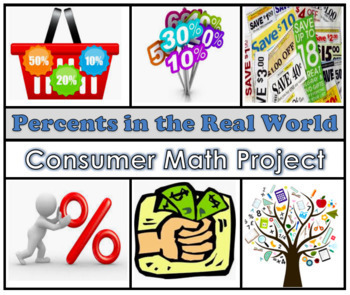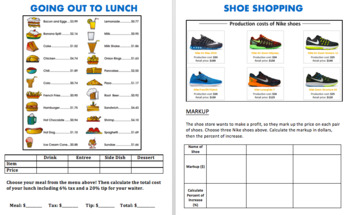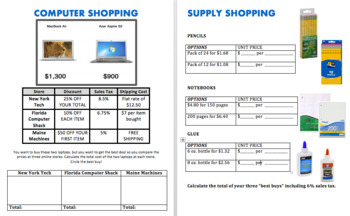CONSUMER MATH PROJECT - Percents in the Real World!
Middle School Math in the Real World
214 Followers
Grade Levels
6th - 8th
Subjects
Resource Type
Standards
CCSS6.EE.B.5
CCSS6.EE.B.7
CCSS6.EE.C.9
CCSS7.EE.B.3
CCSS7.EE.B.4
Formats Included
- PDF
- Easel Activity
Middle School Math in the Real World
214 Followers
Easel Activity Included
This resource includes a ready-to-use interactive activity students can complete on any device. Easel by TPT is free to use! Learn more.
What educators are saying
I used it as an assessment after a unit on percent of change. It covers everything we studied. Great resource.
My students enjoyed the lay out and the different choices of not onloy activites but products. Great conversation going on in my class!
Description
This is a fun, multi-disciplinary project that brings percents, ratios, and rates to life!
My middle school students have a blast applying their new math skills to real-world consumer math problems. They get to practice taking out loans, going out to eat, and shopping for shoes, cars, school supplies, clothes, computers, and more!
The project is aligned to several Common Core standards across 6th, 7th, and 8th grades!
Some of the skills practiced include:
- Tip / Tax / Discount
- Markup & Markdown
- Percent of Change
- Multi-Step Problem Solving
- Unit Price & Unit Rate
- Proportions & Ratios
- Simple Interest
- Commission
- Equations & Inequalities
Total Pages
Answer Key
N/A
Teaching Duration
N/A
Report this resource to TPT
Reported resources will be reviewed by our team. Report this resource to let us know if this resource violates TPT’s content guidelines.
Standards
to see state-specific standards (only available in the US).
CCSS6.EE.B.5
Understand solving an equation or inequality as a process of answering a question: which values from a specified set, if any, make the equation or inequality true? Use substitution to determine whether a given number in a specified set makes an equation or inequality true.
CCSS6.EE.B.7
Solve real-world and mathematical problems by writing and solving equations of the form 𝘹 + 𝘱 = 𝘲 and 𝘱𝘹 = 𝘲 for cases in which 𝘱, 𝘲 and 𝘹 are all nonnegative rational numbers.
CCSS6.EE.C.9
Use variables to represent two quantities in a real-world problem that change in relationship to one another; write an equation to express one quantity, thought of as the dependent variable, in terms of the other quantity, thought of as the independent variable. Analyze the relationship between the dependent and independent variables using graphs and tables, and relate these to the equation. For example, in a problem involving motion at constant speed, list and graph ordered pairs of distances and times, and write the equation 𝘥 = 65𝘵 to represent the relationship between distance and time.
CCSS7.EE.B.3
Solve multi-step real-life and mathematical problems posed with positive and negative rational numbers in any form (whole numbers, fractions, and decimals), using tools strategically. Apply properties of operations to calculate with numbers in any form; convert between forms as appropriate; and assess the reasonableness of answers using mental computation and estimation strategies. For example: If a woman making $25 an hour gets a 10% raise, she will make an additional 1/10 of her salary an hour, or $2.50, for a new salary of $27.50. If you want to place a towel bar 9 3/4 inches long in the center of a door that is 27 1/2 inches wide, you will need to place the bar about 9 inches from each edge; this estimate can be used as a check on the exact computation.
CCSS7.EE.B.4
Use variables to represent quantities in a real-world or mathematical problem, and construct simple equations and inequalities to solve problems by reasoning about the quantities.






